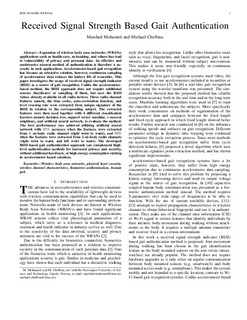| dc.contributor.author | Mohamed, Marshed Kassim | |
| dc.contributor.author | Cheffena, Michael | |
| dc.date.accessioned | 2019-05-09T12:40:26Z | |
| dc.date.available | 2019-05-09T12:40:26Z | |
| dc.date.created | 2018-06-25T09:39:23Z | |
| dc.date.issued | 2018 | |
| dc.identifier.citation | IEEE Sensors Journal. 2018, 18 (16), 6727-6734. | nb_NO |
| dc.identifier.issn | 1530-437X | |
| dc.identifier.uri | http://hdl.handle.net/11250/2597128 | |
| dc.description.abstract | Expansion of wireless body area networks applications, such as health-care, m-banking, and others has lead to vulnerability of privacy and personal data. An effective and unobtrusive natural method of authentication is therefore a necessity in such applications. Accelerometer-based gait recognition has become an attractive solution, however, continuous sampling of accelerometer data reduces the battery life of wearables. This paper investigates the usage of received signal strength indicator (RSSI) as a source of gait recognition. Unlike the accelerometer-based method, the RSSI approach does not require additional sensors (hardware) or sampling of them, but uses the RSSI values already available in all radio devices. Three radio channel features namely, the time series, auto-correlation function, and level crossing rate were extracted from unique signature of the RSSI in relation to the corresponding subject. The extracted features were then used together with four different classification learners, namely decision tree, support vector machine, k-nearest neighbors, and artificial neural network, to evaluate the method. The best performance was achieved utilizing artificial neural network with 95% accuracy when the features were extracted from one on-body radio channel (right wrist to waist), and 98% when the features were extracted from two on-body radio channels (right wrist to waist, and left wrist to waist). The developed RSSI-based gait authentication approach can complement high-level authentication methods for increased privacy and security, without additional hardware, or high energy consumption existing in accelerometer-based solutions. | nb_NO |
| dc.description.abstract | Received Signal Strength Based Gait Authentication | nb_NO |
| dc.language.iso | eng | nb_NO |
| dc.publisher | IEEE | nb_NO |
| dc.relation.uri | https://ieeexplore.ieee.org/abstract/document/8398411 | |
| dc.title | Received Signal Strength Based Gait Authentication | nb_NO |
| dc.type | Journal article | nb_NO |
| dc.type | Peer reviewed | nb_NO |
| dc.description.version | acceptedVersion | nb_NO |
| dc.source.pagenumber | 6727-6734 | nb_NO |
| dc.source.volume | 18 | nb_NO |
| dc.source.journal | IEEE Sensors Journal | nb_NO |
| dc.source.issue | 16 | nb_NO |
| dc.identifier.doi | 10.1109/JSEN.2018.2850908 | |
| dc.identifier.cristin | 1593528 | |
| dc.description.localcode | © 2018 IEEE. Personal use of this material is permitted. Permission from IEEE must be obtained for all other uses, in any current or future media, including reprinting/republishing this material for advertising or promotional purposes, creating new collective works, for resale or redistribution to servers or lists, or reuse of any copyrighted component of this work in other works. | nb_NO |
| cristin.unitcode | 194,64,94,0 | |
| cristin.unitname | Institutt for vareproduksjon og byggteknikk | |
| cristin.ispublished | true | |
| cristin.fulltext | preprint | |
| cristin.qualitycode | 2 | |
